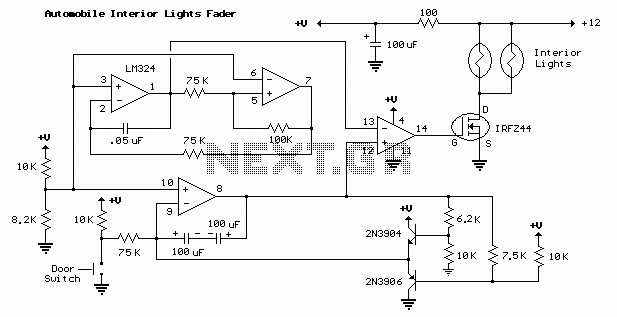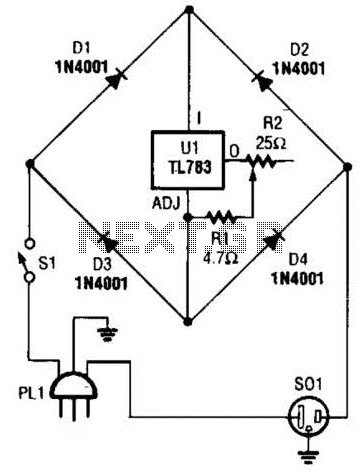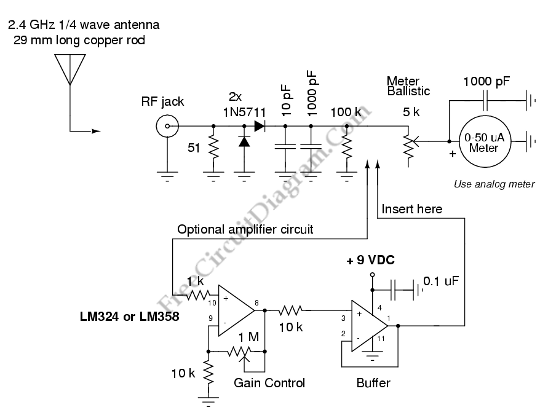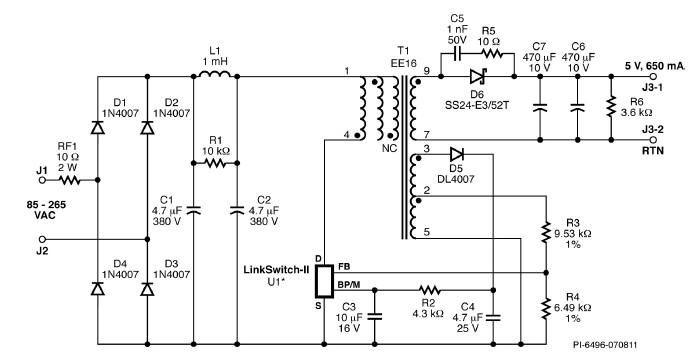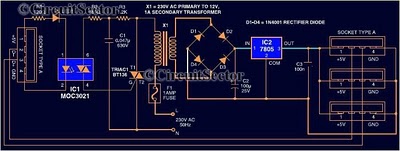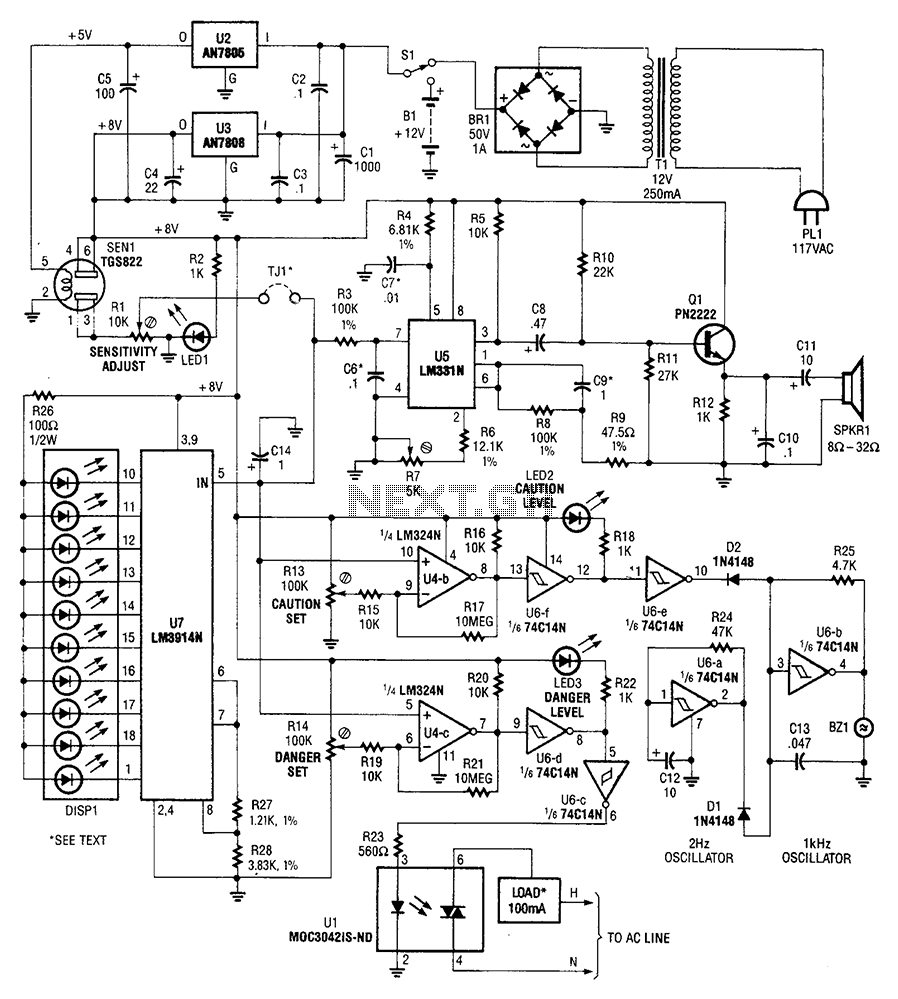
Barricade warning lights flashing circuit
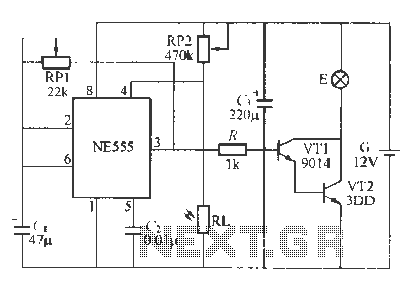
This circuit utilizes battery-powered blinking warning lights for roadblocks. It can operate on AC power to create barricades with warning indicators. The circuit incorporates an NE555 timer and resistors RP1 and RP2, along with resistor R1, to form a light-controlled self-excited multivibrator. A photoresistor (RJ) exposed to bright light during the day exhibits low resistance, causing the NE555 timer to reset when the voltage at the first level drops below 0.4V. This results in the output pin being set to a low level, turning off the small warning light (E). At night, the photoresistor shows high resistance, which allows the voltage at the first level to rise. When it reaches a threshold of approximately 0.4V, the circuit oscillates, causing the warning lights to blink. The NE555 timer's output alternates between high and low, controlling the conduction of transistors VT1 and VT2, which in turn manage the illumination of the warning light. The flicker frequency can be adjusted via RP1, while RP2 modifies the sensitivity of the light control circuit. The circuit operates effectively under appropriate light conditions, using a photoresistor such as the H1 MC45. The transistors should be high-power NPN types, and a 12V car light bulb is recommended, along with a red cover for visibility. A 12V battery powers the entire setup without requiring any additional special components.
The circuit design employs an NE555 timer configured in astable mode to generate a square wave output that drives the blinking warning lights. The photoresistor (RJ) plays a crucial role in determining the operational state of the circuit based on ambient light conditions. During the day, when light levels are high, the resistance of the photoresistor decreases, leading to a voltage drop at the input of the NE555 timer. If this voltage falls below the threshold of 0.4V, the timer resets, causing the output to go low and turning off the warning light (E).
As night falls and light levels decrease, the resistance of the photoresistor increases, which allows the voltage at the NE555 timer's input to rise. Once this voltage exceeds the reset threshold, the timer output goes high, turning on the warning light. The oscillation frequency is determined by the values of RP1 and the capacitor connected to the timer; adjusting RP1 changes the rate at which the output toggles between high and low states, thus controlling the blinking frequency of the warning light.
Transistors VT1 and VT2 are used as switches to drive the warning light. When the NE555 output is high, both transistors conduct, allowing current to flow through the light bulb, illuminating it. Conversely, when the output is low, the transistors turn off, cutting power to the light bulb. This on-off cycling continues as the NE555 timer oscillates, creating a visual alert for roadblocks.
The design is robust and suitable for various outdoor applications, particularly in low-light conditions. The use of a red cover for the light bulb enhances visibility, ensuring that the warning signal is easily discernible to oncoming traffic. The system's reliance on a 12V battery makes it portable and easy to deploy, while the absence of special components simplifies construction and maintenance. Overall, this circuit is effective for enhancing safety at roadblocks through reliable and visible warning signals.Foot using a battery-powered blinking warning lights roadblocks N, can H1 Wu AC power to local roads Shi I make barricades with warning. hF555 and RP1, RP2, (, RI to form a light control type self-excited multivibrator. , a RJ exposed to bright light during the day showed low resistance, NF: 555 forced reset pin end of the first level is less than 0 4V, NF.J55 It was forced to reset output pin to low level .Vll, wT2 off, small warning light E lights. night RI, light irradiation showed a high resistance, accounting for 4 and RP2 partial pressure so that the first foot level rise, when al 0 tv when, uh, they lift the blockade of the circuit, the circuit that is vibrating.
suffer from the principle: no NE5 5 5 feet of low -level, and the circuit is set, pin outputs a high level, feet by RP1 to C, photoelectric, so (,, That first song terminal voltage foot level constantly Ji} when l to 2,73 when the supply voltage, power hoof reset, pin output low, then c, foot by RP1 to discharge, C. Qu terminal voltage that is the first level is not feet fall off. when the power supply voltage is reduced to 1/3, the circuit is set to fork Tacitus, feet high mutation fU flat, fork through RP1 Ask L.
charge ...... Quine undone generates vibration swing so foot mountain high and low output gap, when the pin output high, VT1, VT2 conduction,. E is lit; when feet low when the output, VT1, VT2 off, F goes out. thus cho see as when the tomb of NE555 circuit oscillations, warning lights E will continue flashing light.
can be changed tub twenty RPl f 'song flicker frequency, RP2 adjust the sensitivity of the whole town peel light control circuit, the circuit under appropriate light intensity can be positive for I. Chang. R1. may H1 MC, 45 type and other photosensitive resistor .VT2 require the use of high-power NPN two root canals.
r-cho using state 12V car light bulb, outside the need to install a red shade .G 12V battery. no other special components sister ink requirements.
The circuit design employs an NE555 timer configured in astable mode to generate a square wave output that drives the blinking warning lights. The photoresistor (RJ) plays a crucial role in determining the operational state of the circuit based on ambient light conditions. During the day, when light levels are high, the resistance of the photoresistor decreases, leading to a voltage drop at the input of the NE555 timer. If this voltage falls below the threshold of 0.4V, the timer resets, causing the output to go low and turning off the warning light (E).
As night falls and light levels decrease, the resistance of the photoresistor increases, which allows the voltage at the NE555 timer's input to rise. Once this voltage exceeds the reset threshold, the timer output goes high, turning on the warning light. The oscillation frequency is determined by the values of RP1 and the capacitor connected to the timer; adjusting RP1 changes the rate at which the output toggles between high and low states, thus controlling the blinking frequency of the warning light.
Transistors VT1 and VT2 are used as switches to drive the warning light. When the NE555 output is high, both transistors conduct, allowing current to flow through the light bulb, illuminating it. Conversely, when the output is low, the transistors turn off, cutting power to the light bulb. This on-off cycling continues as the NE555 timer oscillates, creating a visual alert for roadblocks.
The design is robust and suitable for various outdoor applications, particularly in low-light conditions. The use of a red cover for the light bulb enhances visibility, ensuring that the warning signal is easily discernible to oncoming traffic. The system's reliance on a 12V battery makes it portable and easy to deploy, while the absence of special components simplifies construction and maintenance. Overall, this circuit is effective for enhancing safety at roadblocks through reliable and visible warning signals.Foot using a battery-powered blinking warning lights roadblocks N, can H1 Wu AC power to local roads Shi I make barricades with warning. hF555 and RP1, RP2, (, RI to form a light control type self-excited multivibrator. , a RJ exposed to bright light during the day showed low resistance, NF: 555 forced reset pin end of the first level is less than 0 4V, NF.J55 It was forced to reset output pin to low level .Vll, wT2 off, small warning light E lights. night RI, light irradiation showed a high resistance, accounting for 4 and RP2 partial pressure so that the first foot level rise, when al 0 tv when, uh, they lift the blockade of the circuit, the circuit that is vibrating.
suffer from the principle: no NE5 5 5 feet of low -level, and the circuit is set, pin outputs a high level, feet by RP1 to C, photoelectric, so (,, That first song terminal voltage foot level constantly Ji} when l to 2,73 when the supply voltage, power hoof reset, pin output low, then c, foot by RP1 to discharge, C. Qu terminal voltage that is the first level is not feet fall off. when the power supply voltage is reduced to 1/3, the circuit is set to fork Tacitus, feet high mutation fU flat, fork through RP1 Ask L.
charge ...... Quine undone generates vibration swing so foot mountain high and low output gap, when the pin output high, VT1, VT2 conduction,. E is lit; when feet low when the output, VT1, VT2 off, F goes out. thus cho see as when the tomb of NE555 circuit oscillations, warning lights E will continue flashing light.
can be changed tub twenty RPl f 'song flicker frequency, RP2 adjust the sensitivity of the whole town peel light control circuit, the circuit under appropriate light intensity can be positive for I. Chang. R1. may H1 MC, 45 type and other photosensitive resistor .VT2 require the use of high-power NPN two root canals.
r-cho using state 12V car light bulb, outside the need to install a red shade .G 12V battery. no other special components sister ink requirements.
Warning: include(partials/cookie-banner.php): Failed to open stream: Permission denied in /var/www/html/nextgr/view-circuit.php on line 713
Warning: include(): Failed opening 'partials/cookie-banner.php' for inclusion (include_path='.:/usr/share/php') in /var/www/html/nextgr/view-circuit.php on line 713
